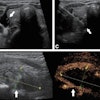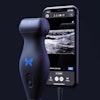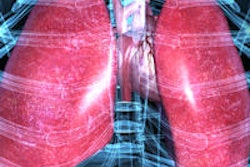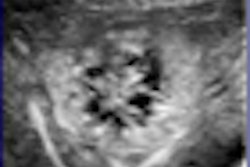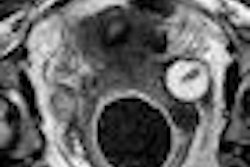A serial two-point compression ultrasound study produced equivalent performance to whole-leg ultrasound in diagnosing suspected deep vein thrombosis (DVT), according to a large-scale, multicenter trial published in the October 8 issue of the Journal of the American Medical Association.
"Both serial two-point ultrasonography plus D-dimer and whole-leg color-coded Doppler ultrasonography represent reliable diagnostic options for the management of symptomatic patients with suspected DVT of the lower extremities," wrote a research team led by Dr. Enrico Bernardi, Ph.D., of Civic Hospital in Conegliano, Italy. "Either strategy may be chosen based on the clinical context, on the patients' needs, and on the available resources."
To assess whether the two diagnostic strategies are equivalent for the management of symptomatic outpatients with suspected DVT of the lower extremities, the researchers performed a prospective multicenter study of 2,465 consecutive outpatients from the ultrasound laboratories at 14 Italian universities or civic hospitals between January 1, 2003, and December 21, 2006 (JAMA, October 8, 2008, Vol. 300:14, pp. 1,653-1,659).
Patients with normal findings were followed-up for three months. Of the 2,465 patients, 345 met one or more exclusion criteria, while 22 refused to participate. The remaining 2,098 patients were randomized to receive either two-point (1,045) or whole-leg (1,053) ultrasound.
Two-point scanning involved examination of the common femoral vein at the groin and the popliteal vein down to its branching into the calf deep veins at the popliteal fossa in the transverse plane with a 5-10 MHz linear probe. Vein incompressibility was the only diagnostic criterion. Patients with normal ultrasound findings received a D-dimer test (used to assist in ruling out active blood clot formation). Those with normal D-dimer levels were not investigated any further and were not anticoagulated, while patients with abnormal D-dimer levels were scheduled for a repeat ultrasound.
As for whole-leg ultrasound, all veins were imaged continuously along their length in the transverse plane using a 5-10 MHz linear probe. The proximal deep veins were imaged first; in patients with normal proximal findings, the calf veins were evaluated. Vein incompressibility was the only diagnostic criterion used for abnormal testing of the proximal and axial calf veins. Adjunctive criteria for abnormal testing of the muscular veins included lack of spontaneous or reverse-flow intraluminal color-filling after augmentation maneuvers, according to the authors.
The researchers found that symptomatic venous thromboembolism occurred in seven of 801 patients (incidence, 0.9%; 95% confidence interval [CI], 0.3%-1.8%) in the two-point strategy group and in nine of 763 patients (incidence, 1.2%; 95% CI, 0.5%-2.2%) in the whole-leg strategy group.
"The two diagnostic strategies are equivalent when used for the management of symptomatic outpatients with suspected DVT of the lower extremities," the authors wrote.
The study team noted that the long-term outcome for each group was quite similar, despite a significantly higher prevalence of DVT in the whole-leg group (absolute difference, 4.3%; 95% CI, 0.5%-8.1%).
"Interestingly, that difference was entirely accounted for by 65 cases of isolated calf DVT identified by whole-leg ultrasonography; thus, one might speculate that detecting isolated calf DVT may not be as relevant as previously believed," the authors wrote.
Also, thorough evaluation of the femoral veins (common, superficial, or deep) and of the popliteal vein did not increase the overall diagnostic yield of the whole-leg strategy, according to the researchers. The initial prevalence of proximal DVT was similar in both groups (22.1% in the two-point strategy group versus 20.2% in the whole-leg strategy group).
"This finding confirms that, in symptomatic outpatients, proximal DVT always involves the common femoral vein, the popliteal vein, or both; and therefore the superficial and deep femoral veins are usually not worth investigating," they wrote.
Either serial two-point ultrasound and D-dimer or whole-leg color Doppler ultrasound may be chosen based on the clinical context, on the patients' needs, and on the available resources, the authors concluded.
"The former is simple, convenient, and widely available but requires repeat testing in one-fourth of the patients," they wrote. "The latter offers a one-day answer, desirable for patients with severe calf complaints, for travelers, and for those living far from the diagnostic service, but is cumbersome, possibly more expensive, and may expose patients to the risk of (unnecessary) anticoagulation."
In an editorial published in the same issue of JAMA, Dr. C. Seth Landefeld of the University of California, San Francisco (UCSF) said that based on the available evidence, it would be reasonable to choose two tests initially -- a clinical prediction rule and D-dimer test, a clinical prediction rule and two-point ultrasonography, or two-point ultrasonography and a D-dimer test.
"If both tests are negative, DVT is effectively ruled out and anticoagulation can be withheld safely," Landefeld wrote. "If DVT is not ruled out, two-point ultrasonography should be performed if not already performed. If DVT has neither been ruled out nor diagnosed by ultrasound, a second ultrasound should be performed one week later; if that ultrasound is negative for DVT, no further testing is indicated. The results of the trial by Bernardi et al show that whole-leg ultrasonography has little advantage, unless a course of anticoagulant therapy for isolated calf DVT is preferable to repeating two-point ultrasonography a week later."
By Erik L. Ridley
AuntMinnie.com staff writer
October 9, 2008
Related Reading
Lack of residual vein thrombosis indicates low risk for recurrent DVT, September 17, 2008
Rapid lysis technique removes DVT, prevents post-thrombotic syndrome, March 5, 2007
New venous thromboembolism diagnosis guidelines specify imaging's role, February 16, 2007
CT venography offers DVT alternative to ultrasound in ICU, August 19, 2005
Device-assisted thrombolysis shortens DVT treatment time, April 5, 2005
Copyright © 2008 AuntMinnie.com

